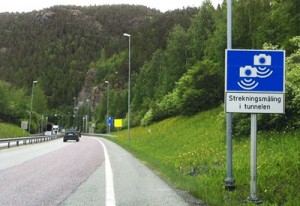
Eight of the section control sites are in tunnels. The results indicate that the crash reductions in tunnels are at least of the same magnitude as on open roads. Photo: TØI
An evaluation of automatic section speed cameras at 14 road sections in Norway found a reduction of the number of injury crashes by between 12 and 22 per cent and a reduction of the number of killed or severely injured road users by between 49 and 54 per cent.
Each section control site consists of a stretch or road between two speed cameras (four speed cameras at sites with bidirectional section control), both of which take pictures of all passing vehicles in one direction with automatic license plate recognition. Average speed is calculated from the times at which the first and second camera is passed. Drivers of vehicles with an average speed above the speed limit may be prosecuted.
The study has controlled for trend, volumes, speed limit changes at some of the sites and speed cameras at some of the sites in the before period. Regression to the mean is controlled for by using the empirical Bayes method which takes into account that exceptionally high crash numbers in the before period usually are associated with a reduction of the number of crashes in the after period, even without any effective safety measure.
Eight of the section control sites are in tunnels. The results indicate that the crash reductions in tunnels are at least of the same magnitude as on open roads.
Most tunnel sites have section control in only one direction. These are for the most part steep downhill sections in subsea tunnels. At such sites the number of injury crashes may be reduced by up to 25 per cent and the number of killed or severely injured road users may be reduced by up to 59 per cent.
The evaluation is financed by The Norwegian Public Roads Administration.
Report:
Evaluation of the crash effects of section control. TØI Report 1339/2014.
Author: Alena Høye.
Link to English summary.
Link to full report in Norwegian.
 Contact: Contact:Alena Høye alh@toi.no TØI, Norway |






Follow us: